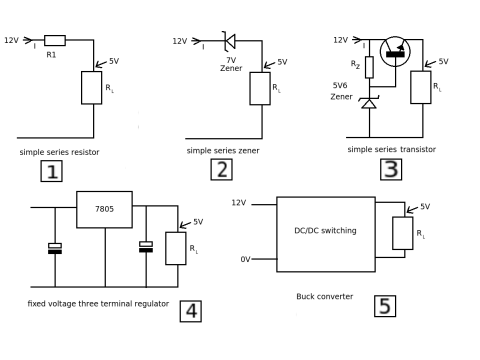Voltage Reduction with a Resistor: Calculation & Application
1️⃣ Can a Resistor Reduce Voltage?
Yes, a resistor can reduce voltage, but this method is mainly suitable for low-power applications due to energy losses.
📌 Common Uses:
✔ LED current limiting
✔ Reference voltage generation
✔ Load protection from overvoltage
✔ Parametric voltage regulation
⚠ Not Recommended for High Power Applications!
Using a resistor to reduce voltage in high-power circuits results in significant heat loss and inefficiency.
2️⃣ How Voltage Drops Across a Resistor
When a resistor is placed in series with a load, the voltage is divided between the resistor and the load according to Ohm’s Law.
Formula for Voltage Drop Across the Resistor:
📌 Key Rules:
✔ Current through the resistor and load is the same (series circuit rule)
✔ The total voltage across both must equal the supply voltage
3️⃣ Practical Calculation Example
Scenario:
We need to power a 9V load (e.g., a small motor) from a 12V power supply, and the load current is 0.5A.
Step-by-Step Calculation:
1️⃣ Determine the required voltage drop:
2️⃣ Calculate the resistor value:
3️⃣ Calculate power dissipation:
⚠ Important: Always use a resistor with at least 2× the calculated power rating to ensure safe operation. In this case, a 3W resistor is recommended.
4️⃣ When to Use a Resistor for Voltage Reduction?
✔ Low Current Applications (≤ 1A)
✔ Simple LED Circuits (e.g., 12V to 3V LED)
✔ Reference Voltage Circuits
✔ Voltage Limiting for Sensors
📌 Example: Using a resistor to safely connect a 3V LED to a 12V power source.
5️⃣ When NOT to Use a Resistor for Voltage Reduction?
🚫 High Current Loads – Excess heat dissipation
🚫 Power Supplies for Motors – Causes voltage fluctuations
🚫 Battery-Powered Circuits – Wastes energy
🚫 Switching Circuits – Ineffective for stable voltage regulation
For efficient voltage regulation in power circuits, use:
✔ Voltage Regulators (e.g., LM7805 for 5V)
✔ Switching Power Converters (e.g., Buck Converters)
6️⃣ Conclusion
✔ A resistor can reduce voltage but is only practical for low-power applications
✔ Always calculate power dissipation to avoid overheating
✔ For efficient voltage regulation, use dedicated voltage regulators
🚀 Next Steps:
✔ Try calculating a resistor for an LED circuit
✔ Measure voltage drop using a multimeter
✔ Compare with a voltage regulator for better efficiency
By understanding how resistors affect voltage, you can design better, more reliable circuits!

